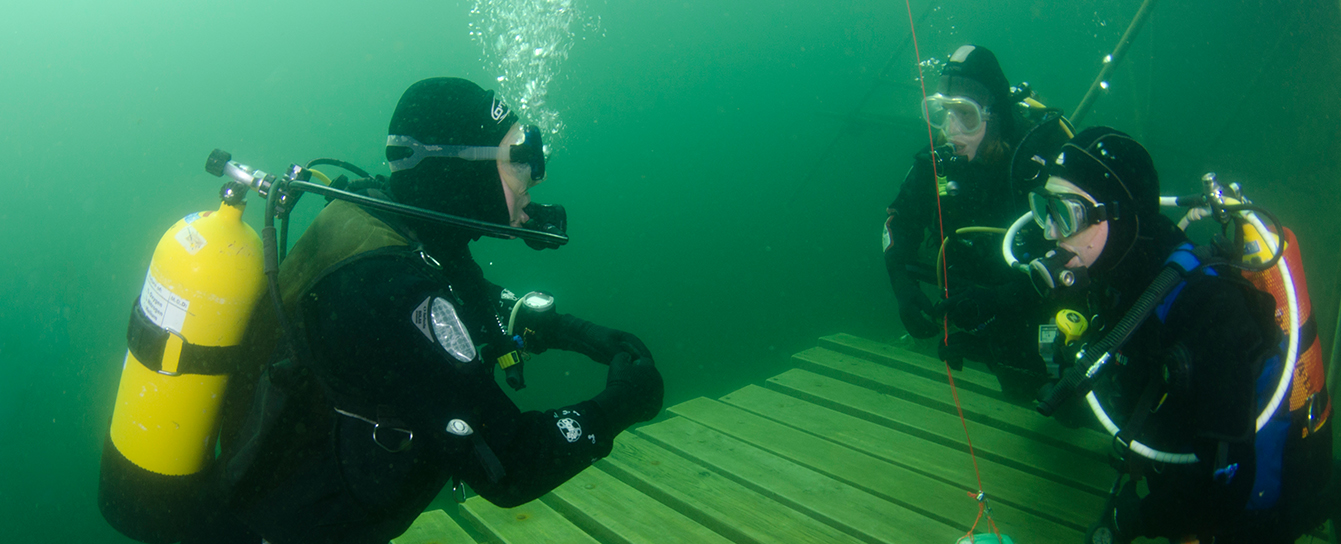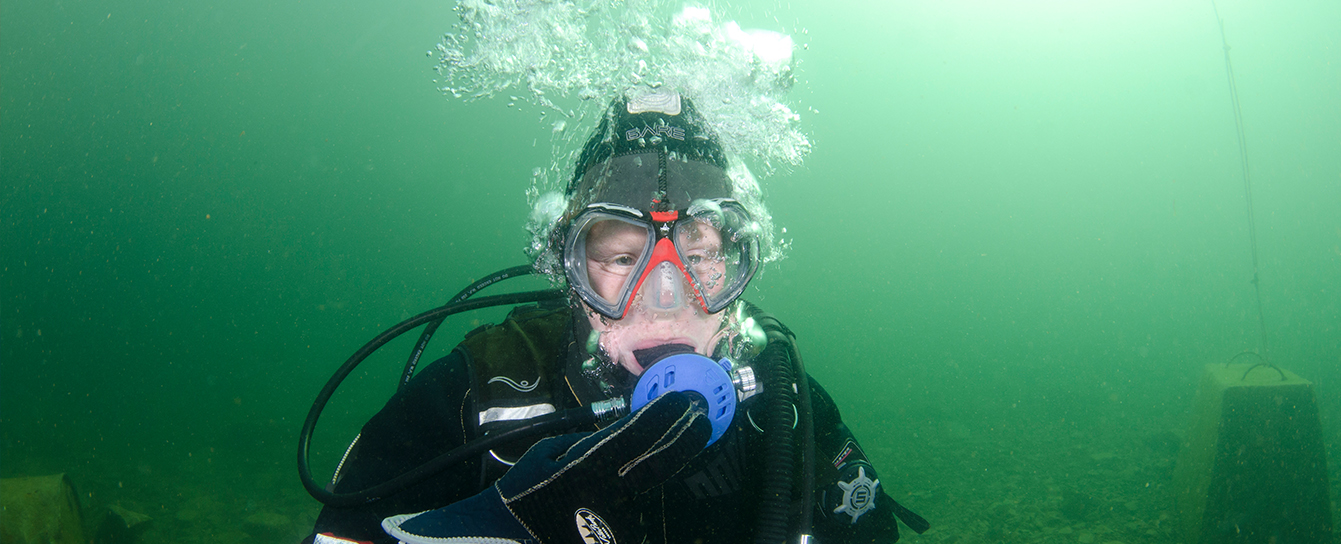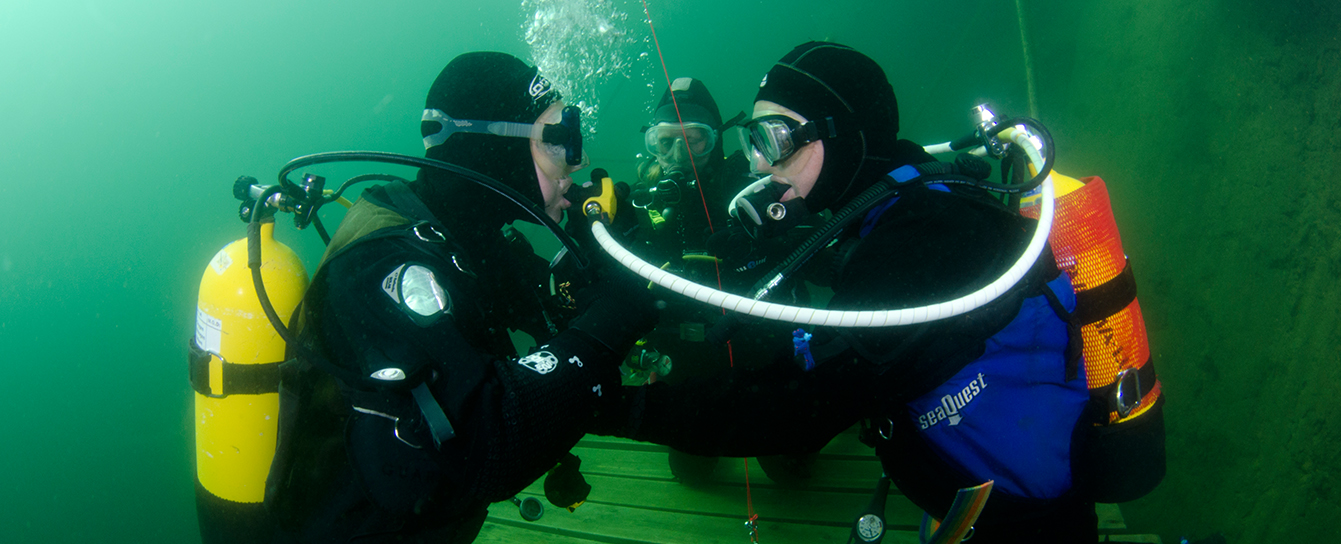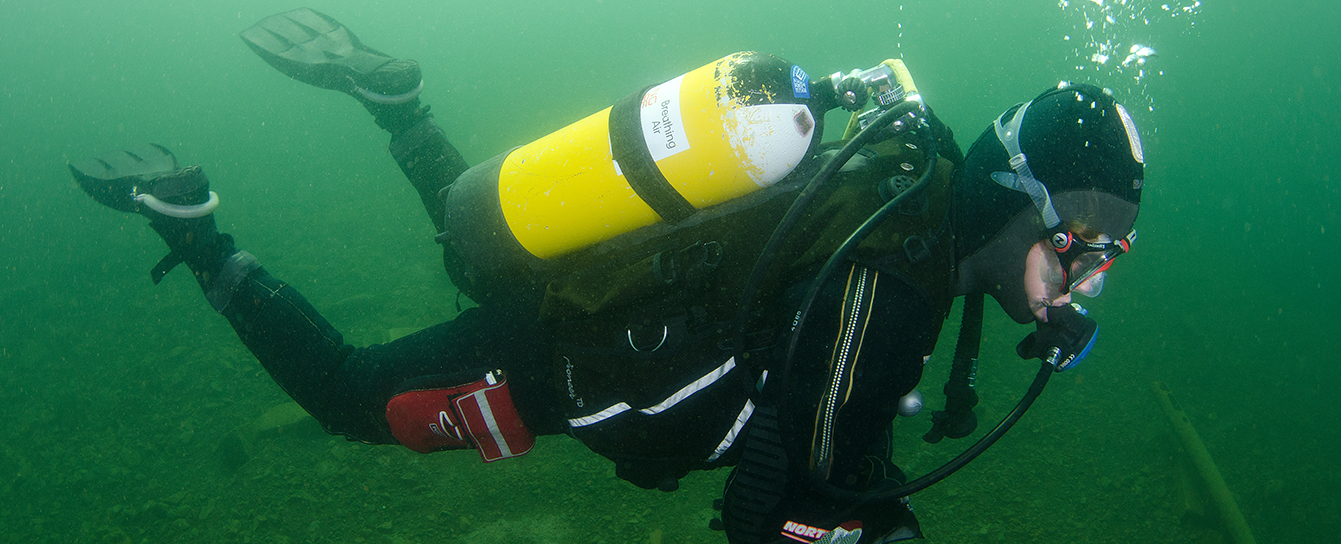
National Instructor, Marg Baldwin, shares her thoughts on the key elements of BSAC’s entry-level Ocean Diver training.
Breathing from a scuba set and experiencing being underwater is a privilege: we are visitors in an alien environment. Throughout our diving journey, we should respect that and do everything we can to protect the environment and ourselves. The BSAC Ocean Diver course is the ideal starting point; good training and practice are paramount. The skills developed in the programme are designed to make safe happy divers. Every skill is important; why and how we do them will be explained and demonstrated by instructors and you will be given time to practice them so that they become second nature.
Just breathe
One of the very first steps is to practice the art of breathing underwater. You will be breathing in and out through your mouth, which may seem strange at first, as we often use our noses for breathing. If you habitually breathe out through your nose underwater, you are likely to unseat your mask and let in water. There will be times when you need to gently blow down your nose into your mask, for example, to put in extra air to prevent the mask squeezing on to your face as you go deeper. A more positive blow down the nose is used to clear out any water that may have got into your mask – this is part of mask clearing, more on that later.

Instructors' note:
If a student is going to breathe out through their nose it will usually happen on the initial submerge using scuba. As you are in standing depth, a quick return to the surface for a brief explanation followed by the introduction of a specific signal in case it happens again should resolve the issue.
Mouthpiece clearing
An early skill to be mastered is how to clear water out of the regulator that you breathe from. If you drop a regulator out of your mouth in or under the water, or it gets knocked out, you need to be able to refit it, clear the regulator of water and carry on breathing. The water can be cleared by a short sharp breath out through the regulator or by introducing air into the regulator by gently pressing the purge button on the front as you bring the mouthpiece back into your mouth. Take your next breath cautiously though, just in case there is any water still lurking in the mouthpiece. If there is, another blow out will clear it.
When you take your regulator out of your mouth to practice clearing it underwater your instructor will have you breathing out small bubbles. This shows you are not holding your breath, which is an important safety rule when scuba diving.
Another reason to be able to clear water from your regulator is that one of the safety skills we practise is breathing from an alternative supply (AS). This skill is used in the rare situation where there is a problem with your regulator or gas supply and you need to be able to change over to another regulator underwater.

Instructors' note:
Encourage students to develop a natural reaction to always blow out first when putting a regulator mouthpiece into their mouth above or below the water.
Using an alternative supply
No one wants to have a regulator problem or run out of gas underwater, fortunately, both are rare occurrences, but it is essential to know what to do should a problem arise. Your instructor will break this important safety skill down into small steps for you to copy so that you can build up to confidently carrying out the whole skill sequence. Watch your instructor closely and if you are unsure what to do, signal that you would like a repeat demonstration. As you practice Alternative Supply (AS) skills you will not be left in a situation with no gas to breathe.
Once you can use an AS in a stationary position, swimming horizontally using an AS will be introduced, the surfacing in a controlled manner using an AS. You and your buddy will each be donor and recipient of an AS during the different stages. The AS training concludes with learning how to support and help one another at the surface, as it is likely the diver with the problem will have no gas to inflate their Buoyancy Compensator (BC). Being able to deal with this and support one another at the surface is important.
In your Ocean Diver training, as with all skills, AS will be initially taught in the pool and revisited in open water. In our normal diving, we are unlikely to use this skill, so it is recommended that, from time to time, you practice the skill. Once qualified, ask one of your branch instructors to supervise your skills practice.

Instructors' note:
Time spent in water of standing depth, where the weight of the equipment is supported, doing a 'dry' run is very valuable. Accentuate the use of a steady pace throughout AS training, demonstrating that this potentially difficult situation can be resolved in a calm manner.
Buoyancy
When we watch scuba diving on television and in films, we are greeted with images of divers moving, apparently effortlessly, through the water. This is achieved through good buoyancy control – a key factor in scuba diving. The very first time you put your scuba set on you will be taught how to use the controls of your Buoyancy Compensator (BC). Every Ocean Diver lesson or dive has an element designed to help you to develop good buoyancy control. As well as using your BC, good buoyancy is achieved through how you breathe and your positioning underwater. There are exercises for you to practice such as pivoting on your fins and hovering just off the bottom to help you develop the combination of these three.
How much weight you wear, and the positioning of the weights are also integral factors in good buoyancy control, particularly as you progress to open-water diving. You will be taught how to check that the weight you are wearing is correct. Over- or under- weighting can make scuba diving difficult. Remember we are aiming to glide through the water, this takes time to achieve - be patient and take every opportunity to practice.
When you go into open water, if you are going to be diving in a drysuit there will be extra training to help you control buoyancy using your suit.

Instructors' note:
When teaching, we focus on watching our students and overlook our own buoyancy and positioning. But the students see our every action, so we need to maintain good buoyancy and positioning. Introducing fun tasks to give students opportunities to practice their buoyancy can be an opportunity to make sure your buoyancy is still to the highest standard. Use regular weight checks to encourage student divers to know they have the correct weight. Using pouch weight belts makes weight adjustment easier.
Ocean Diver classroom and pool training in branches is usually delivered week by week over six to eight weeks, and the open water dives take place soon afterwards. Before you start your training, discuss availability with your instructors and plan accordingly. Try to keep to the planned schedule - delayed training can be frustrating for everyone. Many BSAC centres offer Ocean Diver courses, often run on consecutive days or weekends.
Once qualified as an Ocean Diver, remember your learning has only just started. Regular diving will help you to develop and consolidate your diving skills and abilities. You can dive with an Ocean Diver buddy within the condition you have already experienced during your training and under the supervision of a dive manager or at a managed site. Whenever possible, dive with more experienced divers and explore the options for more dive training t help you continue your journey and your understanding of the underwater environment you are now privileged to visit.
I’m interested in doing a Try Dive (taster session), help me get started!
Send your postcode to hello@bsac.com and we'll send you your three nearest scuba clubs. Or if you fancy a chat call us 0151 350 6226 (Mon - Fri, 9 - 5:30).
This Learning Curve article was originally published in SCUBA magazine, Issue 91 June 2019.
Images in this online version may have been substituted from the original images in SCUBA magazine due to usage rights.

 Author: Marg Baldwin | Posted 19 Aug 2019
Author: Marg Baldwin | Posted 19 Aug 2019


